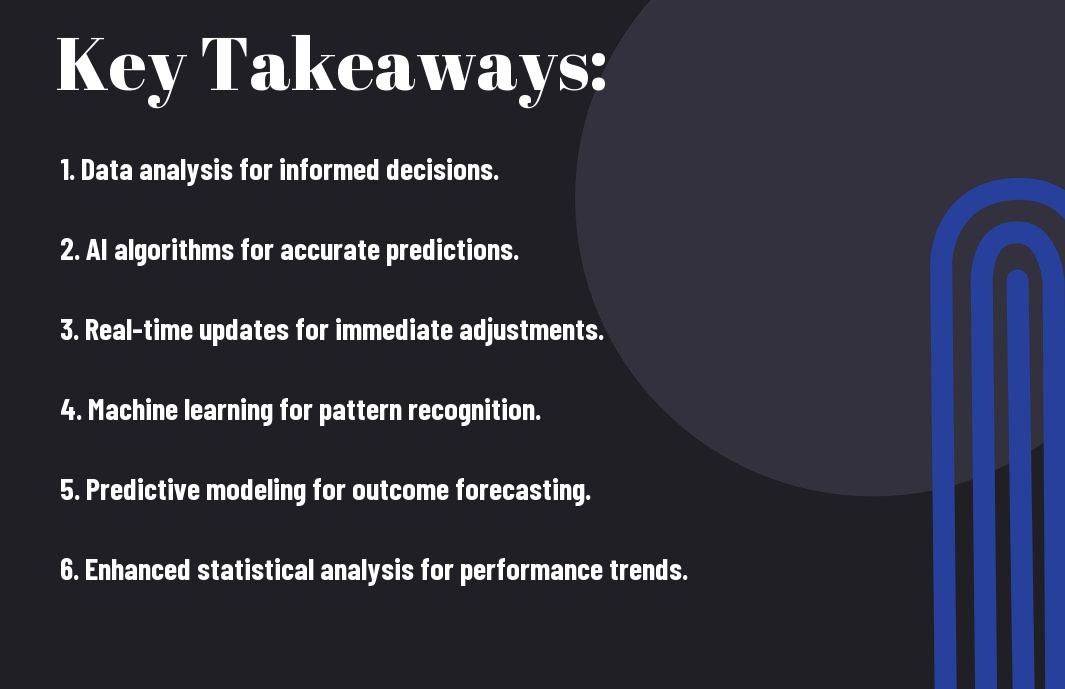Technology plays a pivotal role in refining sports predictions. By incorporating advancements like data analytics software and predictive algorithms, you can sharpen your forecasting skills. Discover the top 5 technologies coaches are using to get 1% better in practice by clicking here. Embrace these tools to elevate your sports prediction game and gain a competitive edge.
Key Takeaways:
- Advanced analytics: Technology and software can analyze vast amounts of data to identify patterns and trends that can help make more accurate sports predictions.
- Machine learning algorithms: Using predictive models, machine learning algorithms can continuously learn from new data to improve the accuracy of sports predictions over time.
- Real-time data: With the use of technology, sports predictions can be made based on real-time data such as player injuries, weather conditions, and team performance, leading to more up-to-date and informed predictions.

The Current State of Sports Predictions
While sports predictions have been a part of the fan experience for decades, the current state of sports predictions still heavily relies on human intuition and traditional methods. However, there are several limitations and inefficiencies in these approaches that technology and software can help overcome.
Limitations of Human Intuition
Current sports predictions often rely on human intuition, which can be subjective and prone to biases. Your own preferences or beliefs about a team or athlete can influence your predictions, leading to inaccurate results. Additionally, human intuition is limited by the amount of data it can process, making it challenging to consider all relevant factors when making predictions.
Inefficiencies in Traditional Prediction Methods
Limitations in traditional prediction methods, such as relying solely on historical data or gut feelings, can lead to subpar accuracy in forecasting sports outcomes. Without comprehensive analysis and data-driven insights, your predictions may lack the depth needed to account for all variables that can impact the result of a game or match.
With the rapid advancements in technology and the availability of vast amounts of sports data, there is a potential to revolutionize the way sports predictions are made. By leveraging software and algorithms, you can enhance the accuracy and reliability of your predictions, giving you a competitive edge in your sports forecasting endeavors.
The Role of Technology in Enhancing Predictions
Even in the world of sports predictions, technology plays a crucial role in enhancing the accuracy and reliability of forecasts. Two key aspects where technology is revolutionizing the prediction process are Data Analytics and Machine Learning, and Real-time Data Processing and Integration.
Data Analytics and Machine Learning
Role of technology is pivotal in leveraging vast amounts of data to identify patterns and trends that humans alone may not easily recognize. By using advanced algorithms and statistical models, technology can analyze player performance, team statistics, weather conditions, and other variables to predict game outcomes with unprecedented accuracy.
Real-time Data Processing and Integration
For sports predictions to be truly effective, real-time data processing and integration are necessary. By continuously integrating live data feeds such as player injuries, weather updates, and game statistics, technology can provide up-to-the-minute insights that enhance the predictive capabilities of algorithms. This instantaneous flow of information enables adjustments to be made on the fly, improving the overall accuracy of predictions.
Enhancing predictions with real-time data processing ensures that you have the most current information at your fingertips when making decisions. This dynamic approach allows for greater adaptability and responsiveness to changing variables, ultimately leading to more precise and reliable sports predictions.
Software Solutions for Sports Predictions
Despite the complexities of sports predictions, technology and software have made significant advancements in enhancing the accuracy of forecast models. One prominent software solution for sports predictions is through advanced statistical modeling.
Advanced Statistical Modeling
- Key Features
- Benefits
| • Machine Learning Algorithms | • Data Visualization Tools |
| • Predictive Analytics | • Real-time Data Integration |
| • Improved Prediction Accuracy | • Quick Adaption to Changing Variables |
| • Enhanced Decision-making Support | • Scalability and Flexibility |
Simulation and Scenario Analysis
With simulation and scenario analysis tools in sports prediction software, you can test various strategies and hypothetical situations to assess their potential outcomes. This feature allows you to anticipate different scenarios and make informed decisions based on the simulated results.
To further enhance your sports predictions, utilizing simulation and scenario analysis empowers you to gauge the impact of changes in player line-ups, weather conditions, or other game variables. By running multiple simulations, you can strategize effectively to maximize your chances of accurate forecasting.
Improving Prediction Accuracy with Technology
Identifying Patterns and Trends
Keep in mind that technology can sift through vast amounts of data quickly and efficiently, allowing you to identify patterns and trends that may not be immediately apparent to the human eye. By utilizing algorithms and machine learning, software can analyze historical data, player performance metrics, weather conditions, and many other variables to uncover valuable insights that can enhance your sports predictions.
Reducing Human Bias and Error
On the other hand, technology can also assist in reducing human bias and error in the prediction process. Humans are naturally susceptible to biases based on personal preferences, emotions, or cognitive limitations. An automated software system can provide a more objective analysis by relying solely on data-driven algorithms, minimizing the impact of human subjectivity on the final prediction.
Human Element in Prediction
An important aspect to consider when using technology to enhance sports predictions is the human element. While software can significantly improve prediction accuracy by identifying patterns and reducing bias, your expertise, understanding of the sport, and intuition still play a crucial role in interpreting the data generated by the technology. By combining the power of technology with your knowledge and experience, you can create more reliable and insightful predictions for a wide range of sports events.

The Impact of Technology on Sports Prediction Markets
Once again, technology is revolutionizing the way sports predictions are made and utilized in the market. The advent of advanced algorithms and machine learning has paved the way for increased accuracy and efficiency in sports prediction markets.
Increased Efficiency and Transparency
The integration of technology has significantly boosted the efficiency and transparency of sports prediction markets. Algorithms can process vast amounts of data quickly and accurately, providing bettors and bookmakers with up-to-date information to make informed decisions. This enhanced efficiency eliminates human error and bias, ensuring a more level playing field for all parties involved.
New Opportunities for Bettors and Bookmakers
An array of new opportunities has emerged for both bettors and bookmakers in sports predictions. For bettors, access to predictive analytics tools and data-driven insights can enhance decision-making and increase the chances of winning bets. Bookmakers, on the other hand, can leverage technology to adjust odds in real-time based on incoming data, thereby optimizing their risk management strategies and improving overall profitability.
Prediction markets are becoming increasingly dynamic and responsive, thanks to technology. With real-time updates and predictive analytics at your fingertips, you can make more informed decisions and potentially gain an edge in the ever-evolving world of sports betting.

Challenges and Limitations of Technology-Enhanced Predictions
Data Quality and Integrity
Challenges in utilizing technology for sports predictions include ensuring the quality and integrity of the data being inputted. As highlighted in Emerging Technologies In Sports Prediction, accurate and reliable data is crucial for making informed predictions. Errors or inconsistencies in the data can significantly impact the accuracy of the results, leading to flawed predictions.
Overreliance on Technology
Overreliance on technology can be a limitation when making sports predictions. While technology can provide valuable insights and analysis, it is important not to solely depend on it for making predictions. It is crucial to balance technological assistance with your own knowledge, intuition, and understanding of the sport. Relying too heavily on technology can overlook important factors that may not be captured by algorithms and data analysis alone.
Technology should be viewed as a tool to augment your predictive capabilities rather than as a definitive source of truth. By combining the power of technology with your own expertise and insights, you can enhance the accuracy and reliability of your sports predictions.
To wrap up
With this in mind, it is evident that technology and software play a crucial role in enhancing the process of making sports predictions. Through the use of artificial intelligence, machine learning algorithms, data analytics, and other advanced technologies, you can have access to valuable insights, trends, and patterns that can significantly improve the accuracy of your sports predictions. By utilizing these tools effectively, you can stay ahead of the game and make more informed decisions when it comes to sports betting.
For further insights into how technology can enhance sports predictions, you can explore James Dooley’s article on Enhancing Sports Betting Strategies with Artificial Intelligence. By embracing the opportunities presented by technology and software, you can elevate your sports prediction game and increase your chances of success in the exciting world of sports betting.
FAQ
Q: How can technology improve the accuracy of sports predictions?
A: Technology can enhance sports predictions by utilizing advanced statistical analysis and machine learning algorithms to process massive amounts of data quickly and accurately. This allows for more informed predictions based on historical data, player statistics, and other relevant factors.
Q: In what ways can software assist in making sports predictions?
A: Software can streamline the prediction process by automating data collection, analysis, and visualization. Predictive modeling software can help identify trends, patterns, and correlations in data that might be missed by manual analysis, leading to more reliable predictions.
Q: How do sports prediction platforms leverage technology to improve user experience?
A: Sports prediction platforms can use technology to offer real-time updates, interactive features, and personalized recommendations based on user preferences. Additionally, mobile apps and online platforms make it easier for users to access predictions, track their performance, and engage with other fans, enhancing the overall user experience.



